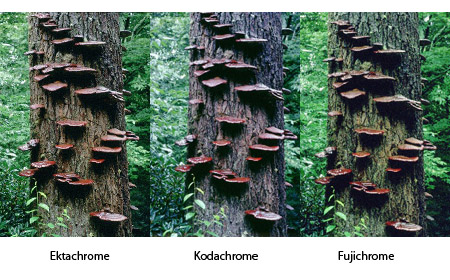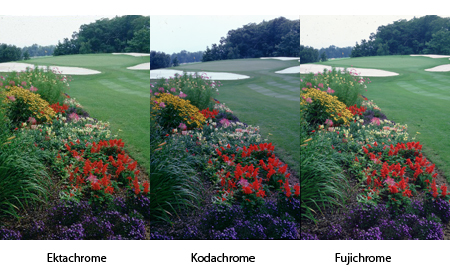 Maybe only photographers would think of this question, but if Paul Simon’s verdant lyric about Kodachrome giving us “the greens of summer” was true, then why, oh why, was Fujichrome invented? At the risk oversimplification, let’s take a look at that question. After all, in his own way, Hugh Morton did!
Maybe only photographers would think of this question, but if Paul Simon’s verdant lyric about Kodachrome giving us “the greens of summer” was true, then why, oh why, was Fujichrome invented? At the risk oversimplification, let’s take a look at that question. After all, in his own way, Hugh Morton did!
The demise of Kodak’s Kodachrome film has made the media rounds recently, and soon after the announcement I thought of writing a post about it (because Morton first used Kodachrome in the early 1950s).
Then, we rediscovered a set of 35mm slides that Morton made where he photographed several subjects with three different films, including Kodachrome. Two of those scenes are represented here as side-by-side scans. Morton’s approach was likely loading three cameras with three different films, setting up a tripod, then swapping out the cameras to make three separate exposures. He picked several scenes until he completed the three rolls of film, then processed all three rolls and compared the results, scene by scene.
To keep this from turning into a complicated photography lesson, let’s just note that manufacturers make different films with different “extended sensitivities.” That means that one film may be more sensitive to reds and yellows, for example, and another film may be more sensitive to greens and blues. This is the case between Kodachrome and Fujichrome, and Kodachrome and Ektachrome. Can you see the differences between the films in the two examples?

When the news of Kodachrome’s death first came out, I had my natural kicked-in-the-gut reaction I get when another hallmark of film photography comes to its fateful end. A friend and I were ruefully exchanging emails discussing Kodachrome’s death blow, and I asked, “When is the last time you shot Kodachrome?” For both of us, the answer was quite a long time ago—so long ago that neither of us could remember precisely. In fact, digital photography has meant that I haven’t shot any type of film in about five years.
One of the standout benefits of digital photography over film photography is its ability to compensate for different types of lighting or adjust the rendering of colors in a particular scene from exposure to exposure, rather than from roll to roll. Depending on your camera and/or imaging software, you can make one exposure, then walk to your computer and easily create variations from that one image that would look similar to all three of Morton’s film examples—and more. This is one more reason that digital photograhy is supplanting film photography, and a contributing factor to the end of Kodachrome’s fabled history.

A very interesting comparison, Stephen. Since I’m not a professional photographer, I always thought of comparing Kodachrome and Ektachrome films by film speed…using Ektachrome when there was less light. Hugh’s test shots clearly show other differences.
I remember in late July, 1972, speaking with George Shivers, a marketing coordinator with Eastman Kodak, about shooting the launch of Apollo 17 from the Kennedy Space Center. The launch was scheduled for 9:53 PM on December 6, 1972…the first night launch of a manned space flight. The initial reaction was, since it will be night, you’ll need some extra speed so the recommendation was High Speed Ektachrome. But NASA’s Dick Young pointed out that a Saturn V night launch will leave a brilliant trail potentially visible over an area three times the size of Texas. Said Young, “never before has a launch schedule called for the gargantuan booster to spew forth its fire and thunder in the darkness of night.” At liftoff, approximately 7,500 foot candles will be emitted and reflected at the base of the launch pad. “It will be like daylight,” Young added. Kodachrome, ASA-25, will be sufficient.
Following an equipment delay, Apollo 17 lifted off from Pad A at KSC’s Complex 39 at 12:33 AM, December 7, 1972. Jack King, “the Voice of Launch Control,” described the final seconds of the countdown this way: “…we have a liftoff and it’s lighting up the area, it’s just like daylight here at Kennedy Space Center as the Saturn V is moving off the pad.” Kodachrome was indeed fast enough.
Had there not been heavy fog over the Southeastern United States, sightings from Alabama, South Carolina, Georgia, and North Carolina could have been made. Apollo 17’s visibility area covered approximately 785,000 square miles.
On December 14, 1972, in a mountain valley on the southeastern edge of the Sea of Serenity called Taurus-Littrow, Apollo 17 Mission Commander Eugene Cernan and Geologist Dr. Harrison Schmitt left man’s last footprints on another world.
Stephen, has anyone determined which Apollo missions Hugh Morton photographed?
Then, there was the time in 1949 when Kodachrome was not fast enough. I related that story in a comment on January 7, 2009.
I remember finding these slides and thinking they were so fascinating. This was right in the middle of my photography class when we were learning how to manipulate colors and such in Photoshop. I remember using film up until a few years ago. But with the technology available I can’t ever imagine going back.
Are there Morton Digital images and files? Did he have the opportunity to experiment with digital cameras and Photo editing software? I would be interested to see what he was able to do with that.
And as always, thanks so much Jack. Your comments are particularly appropo with the recent anniversary of the moon landing.
For many years film speed was, indeed, the major factor in the decision-making equation between Ektachrome and Kodachrome. But film speed only matters, in part, with moving objects. Shooting stationary subjects using a tripod allowed a photographer to choose between the Ektachrome and Kodachrome—or other films, too. I say “in part” because film speed also plays a role in exposure settings, namely the selection of aperture or shutter speed, the combination of which effects the depth of field and amount of blurred motion. (Think of moving leaves on a breezy day—the tree may not move, but the leaves do!) The shutter-speed setting also determines whether a photographer can hand hold the camera or needs a tripod. Usually anything slower than a 60th of a second for steady heads will result in detectable camera movement.
From the mid 1980s until 2007 Kodachrome, was available at ASA 200, expanding the range of conditions that permitted a photographer to use Kodachrome. I think the highest ASA (or ISO) rating for an Ektachrome film is 400, the difference between 200 and 400 being the equivalent of one f/stop.
You have probably run across pictures of fall color taken with three different films, also. As best I recall the circumstances prompting the situation: Hugh hosted some guests of a friend at GGCC on Grandfather the day after we had had dinner with them. While he was walking them back from the deer habitat a photographer also present on the Mountain saw him and called out, “Hey, Hugh, are you still using Fuji film?” The world being as small as it is, one of the guests was at a board meeting the next day with Juanita Krepps who was also on the board of Kodak. It was only a few days before he got a letter from a Kodak VP that was pages long telling him about the virtues of Kodachrome. He set up the comparison shots on several different occasions (If you are promoting a green golf course Fugi is your film of choice.)but one set of pictures of fall color that he sent to the Kodak executive blew the other film out of the water. The reply he got from Kodak was, “You have made my day, my week, and my month.”
Well, most of my family’s history was documented with Kodachrome 64… Somehow my dad usually found enough light or flash to make it come off, and from 1955 thru 1985 it served us thru 35mm, 126 cartridges and (mistakenly) 110 cartridges…
Hugh photographed at least two space launches. I remember being at one launch with him, but I don’t remember which one. It wasn’t the one when Frank Borman went around the moon at Christmas, though Hugh got to know Frank later. Hugh thought the picture Frank took of the earth (It is on a stamp now)was the greatest single picture ever taken, and there is an inscribed copy of it in his old office. Hugh always loved to tell the story about driving Frank up Grandfather Mountain. Part way up Frank said, “My ears popped.” and they both broke out laughing. It wasn’t the moon landing shot either because I remember watching that one with Bill “Mouth of the South” Currie while Hugh gave up on waiting for Armstrong to step out onto the moon and went to bed. But you will find photographs of space launches, any maybe they will be dated.
my late husband raced in the hill climbs back in the 50’s. Are there any records regarding the races?
Hi Joyce, I’m not sure about records, but there are lots of photos of the Sports Car Hill Climbs. I haven’t processed those in detail yet; keep your eyes out for them later this year.
On “CBS News Sunday Morning” today (12/26) there was an excellent report on the final days of Kodachrome.
http://www.cbsnews.com/stories/2010/12/26/sunday/main7185884.shtml?tag=cbsnewsTwoColUpperPromoArea